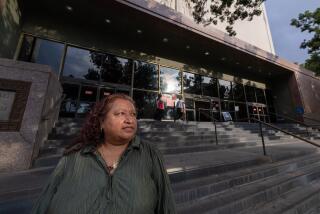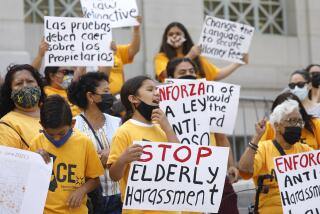L.A. County courts plan will hurt poor tenants, advocates say
Low-income tenants fighting eviction will be disproportionately harmed by a Los Angeles County Superior Court plan to cut costs by reducing the number of courts handling landlord disputes, legal advocates for the poor say.
The number of courthouses hearing such cases will be reduced from 26 to five throughout the county under a plan expected to be implemented by the end of June. Some people will have to travel up to 32 miles to litigate their cases, court officials said.
For some, the trips could take several hours using public transportation and include transfers on multiple trains and buses, said Neal Dudovitz, executive director of Neighborhood Legal Services of Los Angeles County. The travel time is of particular concern in eviction cases because the courts move quickly, he said.
âFor people who are already in great stress and canât really afford to take days off work or have to bring little kids with them wherever they go, itâs really impossible,â Dudovitz said.
Under California law, tenants in most cases have five days to file a written response to the lawsuit brought by their landlords. If the person does not file a response within that time frame, the court rules in favor of the landlord.
The court also enters a judgment in the landlordâs favor if the tenant does not appear in court. Judges typically hear and decide the cases within 20 days after the landlord or tenant requests that the case go to trial.
âThis is not just about a court hearing; this is about peopleâs lives,â Dudovitz said. âThis is where the court in a very real way touches people.... For the low-income community, this is about being able to stay in their homes.â
In the last fiscal year, 67,182 eviction lawsuits, known as unlawful detainer cases, were filed in Los Angeles County courts, said Mary Hearn, a court spokeswoman. Under the courtâs plan, the cases would be heard only in Pasadena, Long Beach, Santa Monica, the Antelope Valley Courthouse in Lancaster and the Stanley Mosk Courthouse in downtown Los Angeles.
When Margaret Howzeâs landlord tried to evict her late last year, Howze traveled by bus from her home in Winnetka to the nearest courthouse in Van Nuys. Twice she made the trip â which she said took more than two hours in one direction â to file her response to the suit and to attend an early-morning hearing in January.
Under the courtâs plan, Howze would have had to travel from the San Fernando Valley to a courthouse in Santa Monica â double the distance she traveled to the Van Nuys courthouse.
Howze said she had worried about arriving on time to her hearing in Van Nuys, knowing that a missed bus could cause her to miss her hearing and lose her case.
âItâs too far,â she said. âWhy would you take something that helps people in the community and take it out and make a hardship for them?â
After her landlord filed the eviction lawsuit, Howze said she worried she would become homeless. In a panic, she called a secondhand store to take her furniture. She had her daughterâs high school diploma and awards packed in a plastic crate and was considering sleeping in a 24-hour laundromat, she said.
Howze made it to her hearing, and the judge dismissed the case because the landlord did not give Howze â who always paid her rent on time â a reason for terminating her tenancy and because the landlord did not show up to the hearing, said Howzeâs attorney, Maria Palomares.
For Howze, who has no vehicle, no Internet access and no familiarity with the Westside, the trip to Santa Monica to have her case heard would have taken away her right to a fair hearing, Palomares said.
âItâs not an inconvenience,â she said. âItâs about protecting your right to your day in court.â
Last week, L.A. City Councilwoman Jan Perry drafted a resolution opposing the removal of eviction cases from the San Fernando Valley.
The travel time to the hubs would create âan insurmountable barrier to the courts for thousands of poor, low-income, disabled, elderly and limited-Englishâspeaking ... residents, who are most often the [unlawful detainer] respondents,â the resolution states. The city has no power over the courtâs plan.
The changes come as the court system works to close a $56-million-to-$85-million budget shortfall by the beginning of the next fiscal year July 1, Hearn said. The assigning of eviction cases to certain courts is part of an overall cost-cutting plan that includes the closure of 10 regional courthouses.
Plans also call for the creation of âtrial hubsâ to handle small claims, collections and personal injury cases.
Court officials say the bulk of savings from the overall plan will come from layoffs. Though it is unclear how many court workers will lose their jobs, the system is âgoing to be laying off many, many employees,â Hearn said.
The Los Angeles County court system already has laid off hundreds of employees and left more positions unfilled. In the last fiscal year, the court system slashed $70 million from its budget, in part by freezing wages and forcing staff members to take furlough days.
âWe have to make changes,â Hearn said, âbecause we donât have the money to provide the level of services, the immediacy of services that we have historically.â
More to Read
Sign up for Essential California
The most important California stories and recommendations in your inbox every morning.
You may occasionally receive promotional content from the Los Angeles Times.











